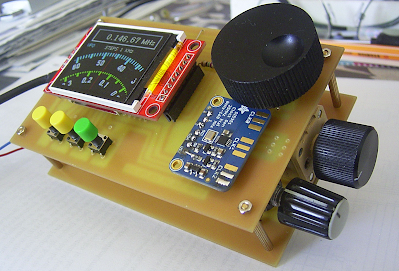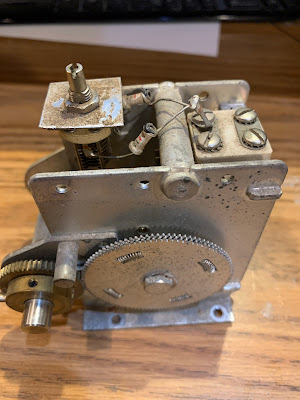Thank you Klaus! And thanks to JF3HZB! (Does anyone have more information on him?)
Podcasting since 2005! Listen to Latest SolderSmoke
Sunday, May 8, 2022
The JF3HZB Digital VFO Dial in the DJ7OO Direct Conversion Receiver (Who is JF3HZB?)
Wednesday, April 13, 2022
The 17 & 12 SSB Transceiver -- Circuit and Build Info -- Video #4
Friday, April 1, 2022
SolderSmoke Podcast #236 -- Bill's 17-12 Rig, Pea Shooter, VFO Wisdom, Temp Compensation, Need Code for Max2870, Making Enclosures, MAILBAG
SolderSmoke Podcast #236 is available!
http://soldersmoke.com/soldersmoke236.mp3
Winterfest! Many Boatanchors. Lots of old good analog test gear. Talk with Dean KK4DAS. Met up with Armand WA1UQO and Charles AI4OT.
Sunday, March 20, 2022
17 - 12 Dual Band SSB Transceiver On-The-Air
Monday, March 14, 2022
"Fashion" for Fans of LC Analog VFOs
Wednesday, March 9, 2022
Video #2 17/12 SSB Transceiver -- Receive RF Amplifier Needed?
Friday, February 25, 2022
Split Stator Temperature Compensation Also Used in Yaesu FT-101
Thursday, February 24, 2022
Old Military Radios at the Air and Space Museum Udvar-Hazy Center, and Autogyros
Wednesday, February 23, 2022
An Analog LC VFO for my 17/12 Meter SSB Transceiver (VIDEO #1)
Saturday, February 19, 2022
Pete's Eclectic Approach to the Pea Shooter, San Jian counters on Analog VFOs, Non-Restaurant Menus
I liked Pete's comments on the various (analog, digital, mixed) approaches to homebrew:
http://n6qw.blogspot.com/2022/02/2022-return-to-peashooter-build.html
http://n6qw.blogspot.com/2022/02/2022-peashooter-20m-compact-ssb.html
I too have San Jian digital counters watching the stability of analog VFOs (DX-100, HQ-100, Mythbuster).
Variety is the spice of life!
I also liked Pete's comment about the fellow who does on-the-air menu counseling for FTDX-3000 owners. I sometimes run into guys on the air who want to do something similar with my simple homebrew rigs. They start by making comments about my audio -- they will usually say it is "too high" or something like that. Especially when I'm using the separate transmitter and receiver (which have to be "netted" imprecisely by ear), I have to explain that maybe resort to their RIT control would help. If they persist, I sometimes have to tell them that how my rig sounds depends A LOT on the placement of the carrier oscillator relative to the passband of the crystal filter (most recently, the filter from the 1963 Swan 240). Most of them have never had to do that kind of adjustment, so the "technical discussion" usually ends at that point, with my interlocutor saying 73, and presumably moving on to someone whose rig has menus to fiddle with. (Recently heard audio techno term: "massaging the codec.")
To each his own!
Tuesday, February 15, 2022
Differential Temperature Compensation Capacitors in the Hallicrafters HT-37 Main VFO Tuning Circuit
Friday, February 4, 2022
Mike WU2D -- VFO Video #3
Tuesday, February 1, 2022
Mike WU2D Shows Us How to Do Temperature Compensation in Homebrew LC Analog VFOs
Thursday, January 20, 2022
Mike WU2D on VFOs (with additional Tribal Knowledge from Frank Harris K0IYE)
Wednesday, October 13, 2021
SolderSmoke Podcast #233: PIMP, Boatanchors, Novices, MMM, Heathkits, DC Receivers, Mailbag
SolderSmoke Podcast #233 is available.
http://soldersmoke.com/soldersmoke233.mp3
Travelogue: Cape Cod. SST. Marconi Site.
The WFSRA: The World Friendship Society of Radio Amateurs.
Pete's Bench:
The Pimp.
The NCX rig.
The Collins.
The many DC receivers built worldwide.
The parts shortages are real! Several key radios on hold. Si5351 sub.
Talk to G-QRP convention
Bill's Bench:
FT-8. Not for me. I tried it.
Novice Station Rebuild.
Globe V-10 VFO Deluxe.
Selenium rectifier removal CONTROVERSY?
Not crazy about my Novice station. Not crazy about CW.
Mate for the Mighty Midget. Again.
Mike W6MAB -- Detector problems LTSPICE Check
One more mod for MMM RX. Ceramic filter at 455.
Dropped screw inside tubular cap on Millen 61455 transformer.
Talk to the Vienna Wireless Society
Thinking of a Moxon or a Hex beam.
BOOK REVIEW Chuck Penson WA7ZZE New Heathkit Book. http://wa7zze.com
Mailbag
-- New SPRAT is out! Hooray!
-- Todd K7TFC sent me copy of Shopcraft as Soulcraft. FB.
-- Dean KK4DAS building an EI9GQ 16 W amp. FB.
-- Jack NG2E Getting close on Pete's DC receiver.
-- JF1OZL's website is BACK!
-- Tony K3DY sent link to cool books.
-- Sheldon VK2XZS thinking of building a phasing receiver.
-- Peter VK2EMU has joined the WFSRA. FB!
-- Ned KH7JJ from Honolulu spotted the Sideband Myth in the AWA video.
-- Chris M0LGX looking at the ET-2, asks about the variometer.
-- Pete Eaton Nov 64 anti HB rant in november 1964 QST. Wow.
-- Josh Lambert Hurley spreading FMLA stickers in the UK. FB
-- Stephen VE6STA getting ready to melt solder.
-- Got a great picture of Rogier PA1ZZ back on Bonaire.
-- Farhan reading the manual of Hans's new digital rig.
-- Paul G0OER wonders if FMLA getting ready to move on 5 meters.
Saturday, October 2, 2021
Selenium RECTIFIED
Selenium rectifiers. The name kind of sounds like Dilithium crystals, possibly related to flux capacitors.
Anyway, there were two of them in the Globe Electronics V-10 VFO Deluxe that I recently bought. Obviously they had to go, so I took them out yesterday, replacing them with a 1N5408 silicon rectifier.
The new diode had a significantly lower voltage drop than the selenium rectifiers -- this pushed the output voltage from the power supply up to around 200V. It is supposed to be around 185 V. So I put a 470 ohm, 5 watt resistor (found in the junkbox) in series. This brought the output voltage to 167 V. Close enough. VFO seems to be working fine.
I'm glad I did the extraction before these aging components released their nasty toxic smoke.
W3HWJ has a good article on replacing these nasty old parts, with some interesting info on their history: http://www.w3hwj.com/index_files/RBSelenium2.pdf
Backgound on the element Selenium: https://en.wikipedia.org/wiki/Selenium
Wednesday, September 29, 2021
N2CQR (WN2QHL) Novice Station Re-Created
Saturday, July 17, 2021
Mythbuster Video #7: Bandswitch, Reverse Polarity Protection, CW with Clarifier Offset
I have the speaker mounted on the front of the board. I kind of like it like that. I now have a bandswitch, and reverse polarity protection (no more living dangerously for me). That Yaesu VFO clarifier circuit might prove useful should I decide to give this rig CW capability. I once again find myself thinking that I might never put this in a metal box. Frank Jones had the right idea.














































